| Article ID | Journal | Published Year | Pages | File Type |
|---|---|---|---|---|
| 5980837 | JACC: Cardiovascular Interventions | 2015 | 7 Pages |
ObjectivesThe goal of this study was to examine the calibration of a validated risk-adjustment model in very high-risk percutaneous coronary intervention (PCI) cases and assess whether sites' case mix affects their performance ratings.BackgroundThere are concerns that treating PCI patients with particularly high-risk features such as cardiogenic shock or prior cardiac arrest may adversely impact hospital performance ratings. However, there is little investigation on the validity of these concerns.MethodsWe examined 624,286 PCI procedures from 1,168 sites that participated in the CathPCI Registry in 2010. Procedural risk was estimated using the recently published Version 4 National Cardiovascular Data Registry (NCDR) PCI risk-adjusted mortality (RAM) model. We calculated observed/expected mortality using several risk classification methods, and simulated hospital performance after combining their highest risk cases over 2 years into a single year.ResultsIn 2010, crude in-hospital PCI mortality was 1.4%. The NCDR model was generally well calibrated among high risk, however there was slight overprediction of risk in extreme cases. Hospitals treating the highest overall expected risk PCI patients or those treating the top 20% of high-risk cases had lower (better) RAM ratings than centers treating lower-risk cases (1.25% vs. 1.51%). The observed/expected ratio for top-risk quintile versus low-risk quintile was 0.91 (0.87 to 0.96) versus 1.10 (1.03 to 1.17). Combining all the high-risk patients over a 2-year period into a single year also did not negatively impact the site's RAM ratings.ConclusionsEvaluation of a contemporary sample of PCI cases across the United States showed no evidence that treating high-risk PCI cases adversely affects hospital RAM rates.
